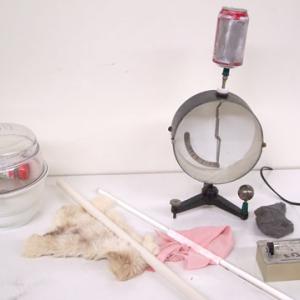College of Liberal Arts & Sciences
7A10.10 - Photoelectric Effect in Zinc
Video Credit: Jonathan M. Sullvan-Wood.
Polish the zinc plate with the steel wool immediately before doing the demo. Charge the electroscope with the negative rod. Note that you can discharge the electroscope only with the short wavelength UV light or the arc lamp. Next charge the electroscope with the positive rod. Note that the UV lights can not discharge the electroscope as there is no excess of electrons to drive off.
This experiment can also be done with aluminum instead of the zinc as aluminum has an almost identical work function. A simple aluminum plate that works well can be made by sanding the paint off an aluminum pop can and attaching it to your electroscope. Then just use it as you would the zinc plate. You will have to also rub the aluminum with steel wool before each use to strip off the aluminum oxide coating that develops rather quickly.
NOTE: It is easier to sand the paint off the pop can if the pop can is unopened. Once you have an appreciable area sanded exposing the aluminum metal, you can open the can, drink the contents, and THEN perform the demonstration.
- Athanasios Gkourmpis, "A Demonstration fo the Photoelectric Effect With Sunlight, TPT, Vol. 61, #8, Nov. 2023, p. 710.
- James Lincoln, "Devices that Can Identify Positive vs. Negative Charge", TPT, Vol. 55, #7, Oct. 2017, p. 440.
- Adam J. Beehler, "Demonstrating the Photoelectric Effect Using Household Items1,2", TPT, Vol. 48, #5, May 2010, p. 348.
- Scott Calvin, "Following in Einstein's Footsteps: Teaching the Photoelectric Effect", TPT, Vol. 42, #6, Sept. 2004, p. 340.
- Chun Xiao Chen and Chang Geng Zhang, "New Demonstration of Photoelectric Effect", TPT, Vol. 37, #7, Oct. 1999, p. 442.
- Michael Grote and William Heinmiller, "Sunscreens and the Photoelectric Effect", TPT, Vol. 34, #9, Dec. 1996, p. 549.
- Joseph L. Spradley, "Hertz and the Discovery of Radio Waves and the Photoelectric Effect", TPT, Vol. 25, #8, Nov. 1988, p. 492.
- Wojciech Dindorf, Bronislaw Tokar, and Andrzej Wolf, "Three Nice Demos", TPT, Vol. 24, #6, Sept. 1986, p. 353.
- Carl H. Hayn, "Analogy for Einstein's Photoelectric Equation", TPT, Vol. 20, #5, May 1982, p. 314.
- Doug Hepburn, James Nelson, and Frederick Lobkowicz, "Photon Collisions", TPT, Vol. 19, #8, Nov. 1981, p. 566.
- Ed Rak and Frederick Lobkowicz, "Questions Students Ask", TPT, Vol. 17, #6, 1979, p. 388.
- Billy Tolar, "Experiments With a Photoelectric Electroscope", TPT, Vol. 14, #8, Nov. 1976, p. 502.
- Richard S. Siegel, "Preferential Discharge of Negatively Charged Bodies by Certain Incandescent Wires or, The Case of the Overachieving Quanta", TPT, Vol. 7, #4, Apr. 1969, p. 226.
- The AAPT Committe, "Apparatus for Teaching Physics - Photoelectric Current in Air", TPT, Vol. 4, #6, Sept. 1966, p. 282.
- Donald S. Ainslie, "Circuits for Demonstration Experiments With a Photoelectric Cell", TPT, Vol. 1, #8, Nov. 1963, p. 229.
- Andrew Ahlgren, "Inexpensive Apparatus for Studying the Photoelectric Effect and Measuring Planck's Constant", TPT, Vol. 1, #4, Oct. 1963, p. 183.
- G. D. Earle, B. L. Copp, J. H. Klenzing, and R. L. Bishop, "A Novel Empirical Study of the Photoelectric Effect in Thin Gold Films", AJP, Vol. 71, #8, Aug. 2003, p. 766.
- Harold Brower, "Demonstration of the Photoelectric Effect With a Geiger Counter", AJP, Vol. 44, #3, March 1976, p. 305.
- J. E. Miller, A. R. Reed, D. P. Miller, "Photoelectric Charging of an Electroscope", AJP, Vol. 34, #2, Feb. 1966, p. 172.
- G. F. Robinson, "Photoelectric Charging of an Electroscope", AJP, Vol. 33, #6, Sept. 1965, p. 746.
- Gary Williams, "Photoelectric Effect Can be Memorable Without Being Expensive", Physics Education, Vol. 39, #2, Mar. 2004, p. 132.
- Richard E. Berg, "Photoelectric Charging of an Electroscope", PIRA Newsletter, Vol. 5, #1, Sept. 1990, p. 2.
- D. Rae Carpenter Jr. and Richard B. Minnix, "S-095. Photoelectric Effect on Zinc", DICK and RAE Physics Demo Notebook, 1993.
- G. D. Freier and F. J. Anderson, "Ok-3. Photoelectric Effect", A Demonstration Handbook for Physics.
- Wallace A. Hilton, "A-4b. The Photoelectric Effect", Physics Demonstration Experiments at William Jewell College, p. 107.
- Borislaw Bilash II and David Maiullo, "Photoelectric Effect", A Demo a Day: A Year of Physics Demonstrations, p. 356 - 357.
- "Directions For Use - Pair of Spiral Electrodes, Zinc Plate, Plastic Plate", Leybold-Heraeus & Co., 1978.
- "Photoelectric Effect Demonstration", DC Electronics Catalog, p. 7.
- "Physics Experiment #5 (Series I): Photo-Electric Effect", Keithley Instruments.
- Curt Suplee, "The Photoelectric Effect", Everyday Science Explained, National Geographic, p. 124 - 125.
- W. Bolton, "34. Photo-Electricity", Book 2 - Waves and Particles, Physics Experiments and Projects, 1968, p. 54 - 56.
Disclaimer: These demonstrations are provided only for illustrative use by persons affiliated with The University of Iowa and only under the direction of a trained instructor or physicist. The University of Iowa is not responsible for demonstrations performed by those using their own equipment or who choose to use this reference material for their own purpose. The demonstrations included here are within the public domain and can be found in materials contained in libraries, bookstores, and through electronic sources. Performing all or any portion of any of these demonstrations, with or without revisions not depicted here entails inherent risks. These risks include, without limitation, bodily injury (and possibly death), including risks to health that may be temporary or permanent and that may exacerbate a pre-existing medical condition; and property loss or damage. Anyone performing any part of these demonstrations, even with revisions, knowingly and voluntarily assumes all risks associated with them.

